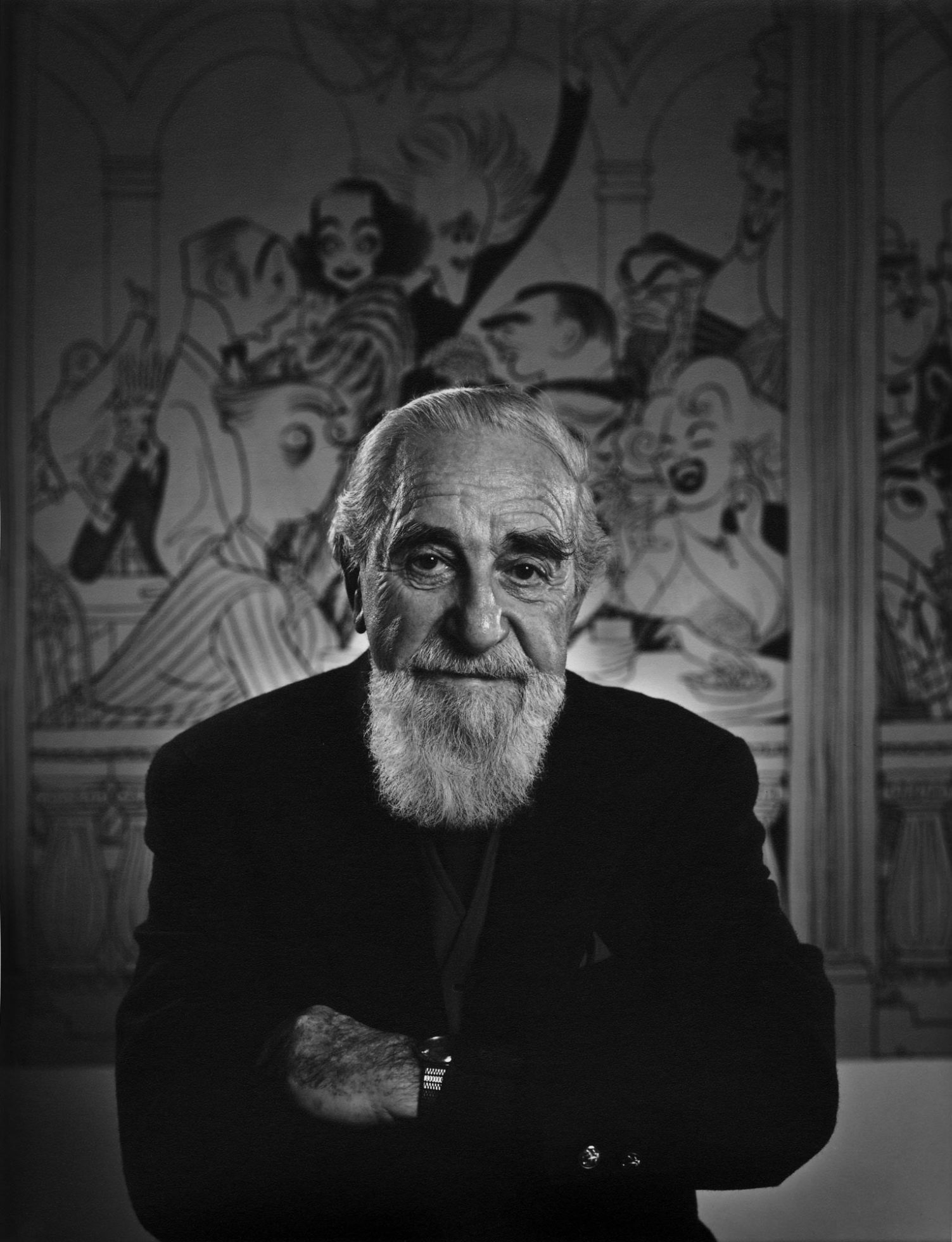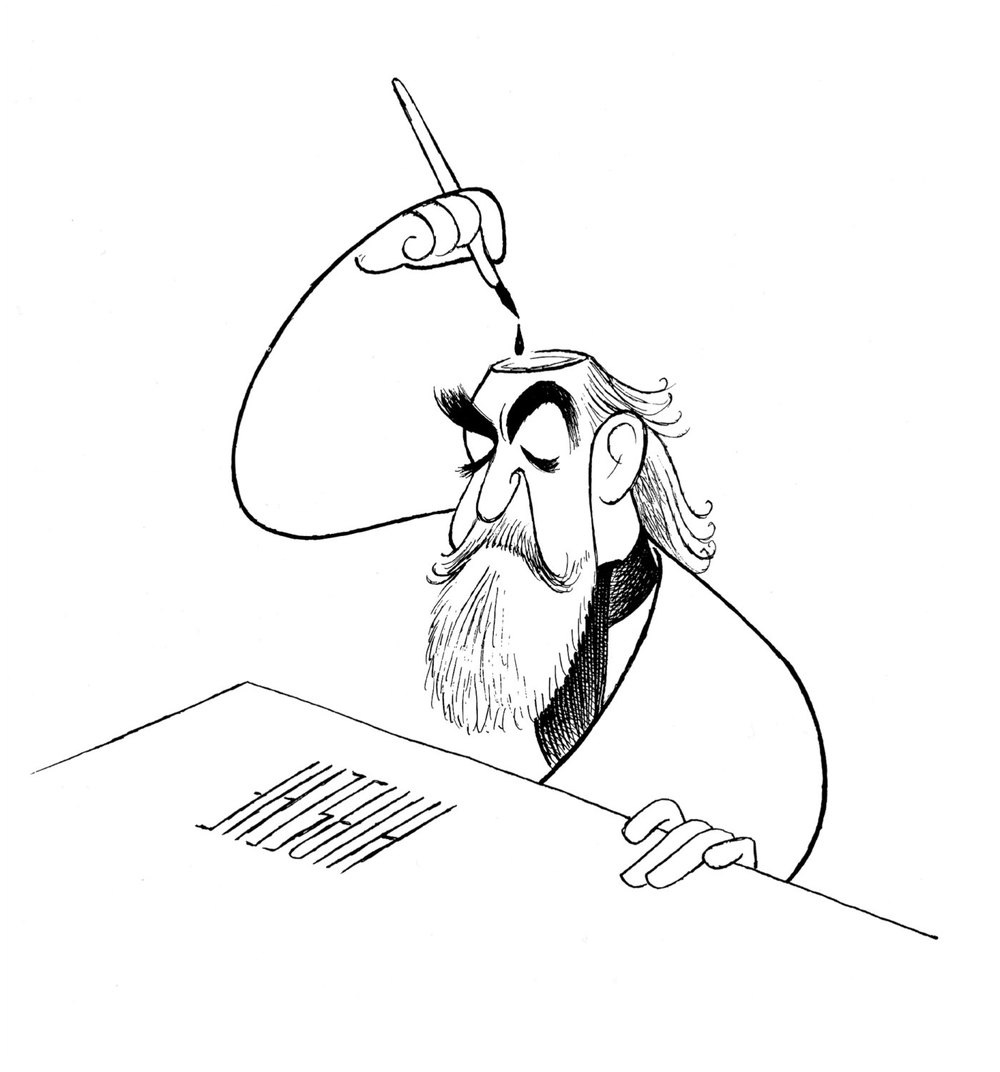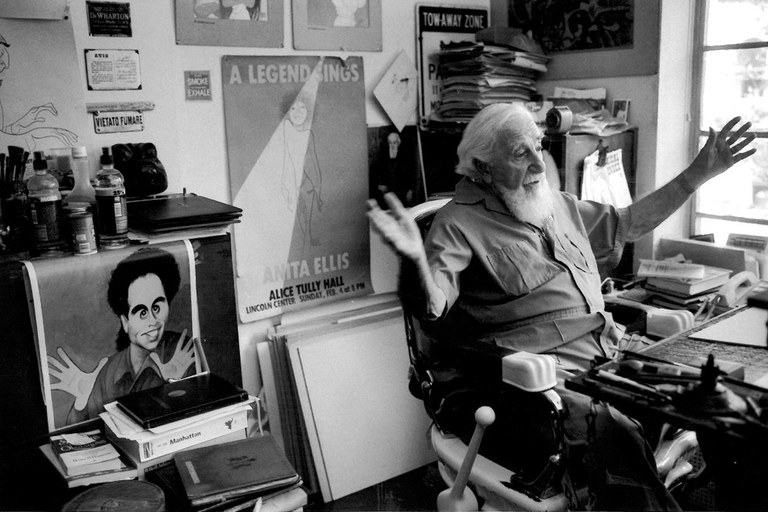Al Hirschfeld, 99, Dies; He Drew Broadway
By Richard F. Shepard With Mel Gussow
Jan. 21, 2003
Al Hirschfeld, whose inimitable caricatures captured the vivid personalities of theater people and their performances for more than 75 years, died at his home in Manhattan yesterday. He was 99.
In 1996 a film documentary of the artist's life by Susan W. Dryfoos, ''The Line King,'' rich in tributes from those he had drawn and from those he worked with, was nominated for an Academy Award. That year he was also named as one of six New York City landmarks by the New York Landmarks Conservancy.
Mr. Hirschfeld was best known for the caricatures that appeared in the drama pages of The New York Times. But his work also appeared in books and other publications and is in the collections of many museums, including the Metropolitan Museum of Art, the Museum of Modern Art and the Whitney Museum of American Art in Manhattan and the St. Louis Art Museum, in his hometown. His other artistic work often reflected his travels to the South Pacific and to Japan, where he was deeply influenced by aesthetics and techniques.
''The art of caricature, or rather the special branch of it that interests me, is not necessarily one of malice,'' the artist wrote in an introduction to his 1970 book, ''The World of Hirschfeld.''
Mr. Hirschfeld cut a striking figure, a lively, white-haired, white-bearded man about 5 feet 8 inches tall, who saw himself this way: ''A couple of huge eyes and huge mattress of hair. Large eyes with superimposed eyebrows. No forehead. The forehead that you see is just the hair disappearing.''
He was never at a loss for words or pictures; in the 1930's and 40's he wrote pieces on comedians, actors, Greenwich Village and films for The Times. In one he sharply criticized ''Snow White,'' Walt Disney's animated movie, for imitating ''pantographically'' factual photography and for being in the ''oopsy-woopsy school of art practiced mostly by etchers who portray dogs with cute sayings.''
His own finished products were completed mostly on the drawing board next to the barber's chair he used while working in the Manhattan brownstone in the East 90's that he shared with his wife, the actress Dolly Haas (who died in 1994), and later with Louise Kerz Hirschfeld.
The Hirschfeld story began on June 21, 1903, when Albert Hirschfeld was born in St. Louis, one of three sons of Isaac and Rebecca Hirschfeld.
When he was 12 years old and had already started art lessons, the family moved to New York City. He attended public schools and the Art Students League. By 18, he art director for Selznick Pictures. In 1924 he went to Paris where he continued his studies in painting, sculpture and drawing.
It was during a trip to Bali -- where the intense sun bleached out all color and reduced people to ''walking line drawings,'' as he later recalled -- that he became ''enchanted with line'' and concentrated on that technique.
While on a visit to New York in 1926 from Paris, he went to the theater one evening with Richard Maney, a press agent who was handling his first show, a production that starred Sacha Guitry, the French star, in his first American performance.
With a pencil, Mr. Hirschfeld doodled a sketch in the dark on his program. Maney liked it and asked Mr. Hirschfeld to repeat it on a clean piece of paper that could be placed in a newspaper. It appeared on the front page of The New York Herald Tribune, which gave him more assignments.
Some weeks later, the artist received a telegram from Sam Zolotow of The Times's drama department asking for a drawing of Harry Lauder, who was making one of his numerous farewell appearances. Mr. Hirschfeld delivered it to the messenger desk at the newspaper. A few weeks later, he had another assignment from The Times.
This went on for about two years, he later recalled, until he first met Zolotow in a theater lobby. He was told to deliver his next drawing in person, and he did, making the acquaintance of Brooks Atkinson, then The Times's drama critic, who became a close friend. Mr. Hirschfeld was never a salaried employee of The Times but worked on a freelance basis that left ownership of his work in his hands after it had been published in the newspaper.
He applied his art to other subjects elsewhere. In the 1920's and early 30's, imbued with a sense of social concern, Mr. Hirschfeld did serious lithographs that appeared, for no fee, in The New Masses, a Communist-line magazine. Eventually, he realized that the magazine's interest was politics rather than art. After a dispute about a caricature he had made of the Rev. Charles E. Coughlin, the right-wing, anti-Semitic radio priest, the artist renounced a political approach to his work and, in his book, ''The World of Hirschfeld,'' later wrote, ''I have ever since been closer to Groucho Marx than to Karl.''
The Hirschfelds' daughter, Nina, was born in 1945. On Nov. 5 of that year, her name made its debut in the pages of The Times, on an imagined poster in a circus scene for a drawing about a new musical, ''Are You With It?'' The world may have lost track of the show but it kept up with Nina, a name covertly insinuated into a caricature several times -- perhaps in the fold of a dress, a kink of hair, the bend of an arm.
So popular did the Ninas become that the military used them in the training of bomber pilots to spot targets. A Pentagon consultant found them useful in the study of camouflage techniques. Mr. Hirschfeld realized how addicted readers had become to Ninas when he purposely omitted them one Sunday only to be besieged by complaints from frustrated Nina hunters.
One Nina fan was Arthur Hays Sulzberger, then the publisher of The Times. In 1960 he wrote a letter to Mr. Hirschfeld to say that he always first looked for Ninas in Hirschfeld drawings but had learned that each included more than one.
''That really isn't fair, since not knowing how many there are leaves one with a sense of frustration,'' Sulzberger wrote.
A letter from another reader suggested that the artist note in the caricature how many times a Nina appeared. From that time on, Mr. Hirschfeld appended the number of Ninas in the lower right-hand corner of each drawing. Mr. Hirschfeld believed that acceptance of caricatures was a slow process and one that was always difficult for the artist. Occasionally actors and producers hinted at lawsuits or withdrawal of advertising because they did not find his drawings sufficiently attractive.
But his art flourished and endured, and it sometimes seemed as if there were Hirschfelds at every point of the compass. He was represented for more than a quarter of a century by the Margo Feiden Galleries, which once estimated that there were more than 7,000 Hirschfeld originals in existence. One that is no longer in existence is a Hirschfeld self-portrait reproduced in paint on Madison Avenue between 62nd and 63rd Streets, in front of the gallery in 1994. It was 48 feet long, complete with Ninas, and survived a partial washout by rain the first day.
In 2000 Mr. Hirschfeld had a dispute with Ms. Feiden, filing a suit in State Supreme Court in Manhattan. Mr. Hirschfeld subsequently dropped the case, and the two signed another contract, which gave the artist control over the exhibition of his drawings in museums.
If you could not join Hirschfeld, you could lick him. In 1991 the United States Postal Service issued a booklet of five 29-cent stamps honoring comedians -- Stan Laurel and Oliver Hardy, Edgar Bergen and Charlie McCarthy, Jack Benny, Fanny Brice and Bud Abbott and Lou Costello -- as designed by the artist; contrary to post office policy forbidding secret marks, he was allowed to insert his trademark Ninas into the depictions.
In the early 1940's he and a close friend, the writer S. J. Perelman, collaborated on a musical with Ogden Nash and Vernon Duke. It was called ''Sweet Bye and Bye'' and opened and closed in Philadelphia on the same night.
''We had to leave the country after that,'' Mr. Hirschfeld later said.
Subsequent travels resulted in books -- words by Perelman, pictures by Hirschfeld -- like ''Westward Ha! or Around the World in 80 Clichés'' and ''Swiss Family Perelman.'' Mr. Hirschfeld wrote several books by himself, including ''Show Business Is No Business'' (reissued in 1983) and ''The American Theater as Seen by Hirschfeld.'' ''Hirschfeld on Line'' was published in 1999, followed by ''Hirschfeld's New York'' and ''Hirschfeld's Hollywood,'' published simultaneously with exhibitions at museums in both cities. In June, Applause Books will republish two of his classic works, ''The Speakeasies of 1932'' and ''Hirschfeld's Harlem.''
In 1995, he was enshrined in the online age by a CD-ROM, ''Hirschfeld: The Great Entertainers.'' He received more honors and awards than perhaps any other living American artist. As befitting his longevity, he received two Tony Awards, a special award in 1975 and, in 1984, he was the first recipient of the Brooks Atkinson Award.
Dolly Haas Hirschfeld was his wife, adviser and social director for 52 years. An earlier marriage to Florence Ruth Hobby ended in divorce. In 1996 he married Louise Kerz, a research historian in the arts and a longtime friend, who survives him. He is also survived by his daughter, Nina Hirschfeld West of Austin, Tex.; a grandson, Matthew, and a granddaughter, Margaret, both of Austin; and two stepsons, Jonathan Kerz of Larchmont, N.Y., and Antony Kerz of Rocky Hill, Conn.
His wife said he was elated after receiving two messages on Friday, a letter from the American Academy of Arts and Letters saying that he had been elected to the academy, and a phone call from Washington saying that he would be one of the recipients of the National Medal of Arts, to be presented by President Bush at the White House this year. When he was informed of the honors, he said, ''If you live long enough, everything happens.''
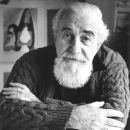
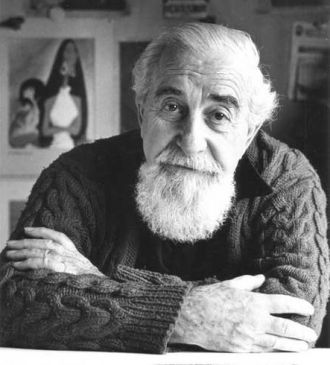
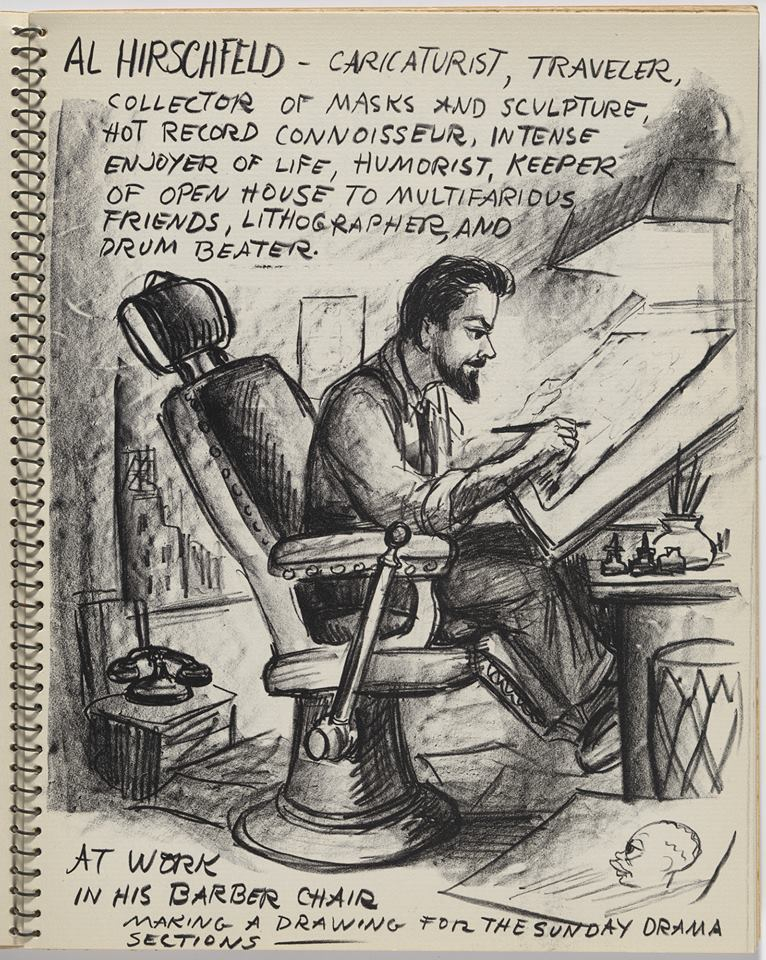
 Amanda S. Stevenson
Amanda S. Stevenson  Jeffrey Shelton
Jeffrey Shelton 
